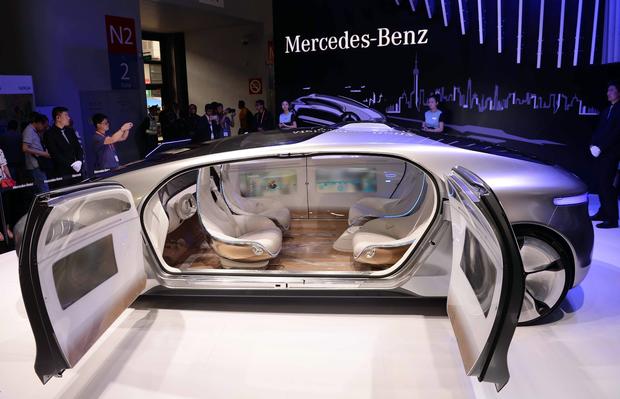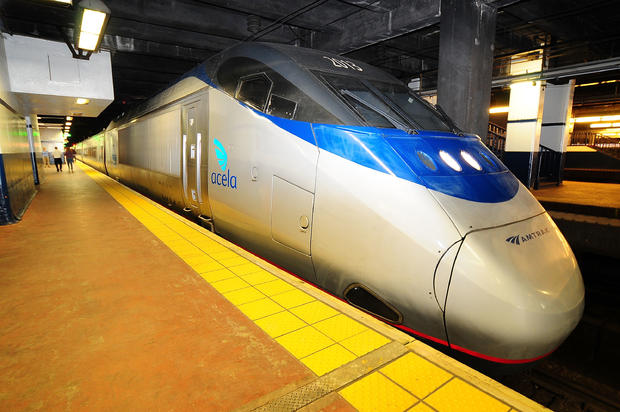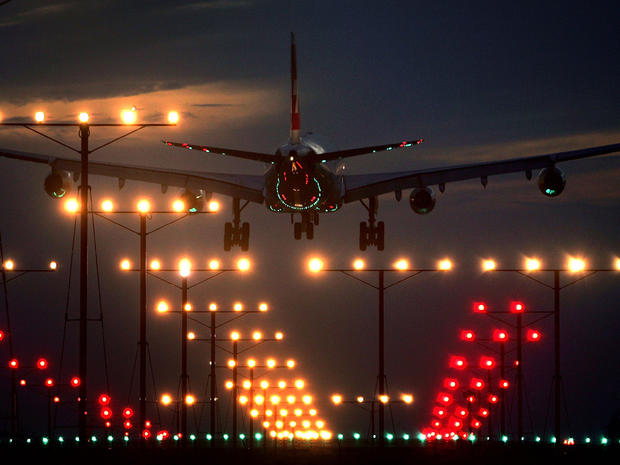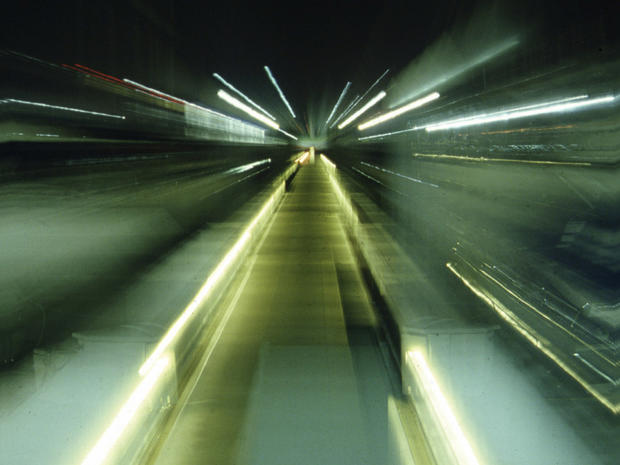Future travel: Flying cars and space hotels
Driverless cars are coming. In fact, their technology has been arriving incrementally for years -- think not just of the Google (GOOG) prototypes but self-parking cars that are already on the roads.
Some of Tesla's (TSLA) Model S cars will soon get updates that includes a test of a self-driving feature, CEO Elon Musk told shareholders just a few weeks ago.
In May at the Hoover Dam, German automaker Daimler rolled out its autonomous semi-truck, which it's testing in Nevada.
And Comet, a consulting firm that specializes in the "robo-revolution," recently told the New York Observer it will roll out automated vehicle pilot projects in six to 10 U.S. cities this year with a target of 30 by 2016.
Plans call for vehicles that will not only take over the driving but actually talk to each other on the roads, promising to significantly reduce crashes.
"My guess would be that we could see fully autonomous vehicles, the technology ready, in the next 10 years. But it may be much longer before see see them, partly because of legal issues, partly because our infrastructure may not be ready for it, it's not entirely clear," Nidhi Kalra, an information scientist at RAND said in an October. "We're progressing rapidly, and now we're trying to get from 99 percent reliable to 99.99 percent reliable and those final fractions of a percent are the hardest to pin down."
And when they do come along, some locations are probably a safer bet than others, at least initially.
What about a place like New York City?
"I would say definitely nothing before 2020, since companies aren't even testing them in New York right now (state law doesn't allow them)" Rodney Stiles, director of research and evaluation at the New York City Taxi and Limousine Commission, said in an email. "But 20 years from now, I could see them getting through the cycle of testing, piloting for passenger service, and acceptance as a mode of transport. That's just my opinion and not our official agency stance."
Hoverboards and flying cars
Although some future transportation ideas may never get off the ground, one prototype from Lexus is doing that in a unique way.
Toyota's (TM) luxury auto brand is working on a skateboard-sized hoverboard called the Slide, which is powered by nitrogen-cooled superconductors and magnets. The technology is similar to the magnetic-levitation propulsion used by some Japanese bullet trains.
A promotional video for the hoverboard shows a skateborder step off his old-fashioned deck and approach a hovering, smokin' new one.
The long game for the technology will be to build flying cars, according to Bloomberg News. "Flying car means the car is just a little bit away from the road, so it doesn't have any friction or resistance from the road," Hiroyoshi Yoshiki, a managing officer in Toyota's Technical Administration Group, said at the Bloomberg Next Big Thing Summit in 2014.
Inside Science talked to Steve Gourlay, the head of the Lawrence Berkeley National Lab's Superconducting Magnet Group, to get an overview of how the hoverboard might work. Among the complexities, he guesses that Lexus may have embedded strong (and expensive) rare-earth magnets in the sidewalk to create a magnetic field to allow the board to hover off the ground.
So, until the price of rare earth minerals comes down, the only place you're likely to see a hoverboard in action is courtesy of Marty McFly in "Back to the Future 2."
Hyperloop and maglev trains
Serial inventor Elon Musk (Space X, Tesla Motors, Solar City) is currently soliciting plans for "pods" for his high-speed Hyperloop system that would connect the San Francisco Bay Area to Los Angeles County.
First proposed in 2013, Musk's Space X company recently announced it will build a sub-scale test track next to its headquarters in Hawthorne, California. More details are expected in August.
In his 2013 white paper, Musk spelled out the proposal in language for the nonscientists. "Short of figuring out real teleportation, which would of course be awesome (someone please do this), the only option for super fast travel is to build a tube over or under the ground that contains a special environment," he wrote.
"Hyperloop consists of a low pressure tube with capsules that are transported at both low and high speeds throughout the length of the tube. The capsules are supported on a cushion of air, featuring pressurized air and aerodynamic lift. The capsules are accelerated via a magnetic linear accelerator affixed at various stations on the low pressure tube with rotors contained in each capsule," Musk said. He put a $6 billion price tag to build two one-way tubes and 40 capsules that would allow 7.4 million people to make the 35-minute trip each year for "$20 USD plus operating costs" per passenger. Top speed: 760 mph.
While the Hyperloop may be the most high-profile of the high-speed transit projects, there are others.
A Washington D.C.-based private company called Northeast Maglev, has funding from the Central Japan Railway Co. in hopes of building a superconducting magnetic levitation-style (SC Maglev) train from Baltimore to D.C. It would travel at 311 mph.
Globally, maglev trains are already reaching superfast speeds, Earlier this year, a maglev train carrying Central Japan Railway employees reached 373 mph on a test track near Mount Fuji.
The Baltimore project isn't even the first maglev proposal for the U.S. A mothballed California-Nevada Interstate Maglev plan sought to build a train to Las Vegas from Anaheim, California. The "California-Nevada Super Speed Train" would have reached speeds above 300 mph.
U.S. higher-speed rail
Unfortunately, when it comes to high-speed rail, the U.S. hasn't been speaking the same language as the rest of the world.
The country's fastest train now the Amtrak-operated Acela, which runs on the Northeast Corridor from Boston to Washington, D.C. Its top speed, only allowed on certain segments, is 150 mph.
Worldwide, about 20 countries have high-speed rail, which usually means speeds well above 150 mph. Japan has high-speed rail for about 50 years, according to the U.S. High Speed Rail Association.
Amtrak's current plans include the Gateway Project infrastructure upgrade to its busy 456-mile Northeast Corridor route (with 16,000 trains per week between Boston and D.C.) along with $3 billion in new Acela-type trains that would eventually be able to reach speeds of 160 mph.
Amtrak's fastest plan on the books, the Next-GenHigh-Speed Rail project, would have a top speed of 220 mph. It would require completely new tracks and in many places, new rights of way to accommodate for gentler curves. If everything was awesome, buildout could begin in 2025. If approved, Amtrak estimates it would take about 30 years to plan and build the 427-mile route between Washington, D.C., and Boston.
Elsewhere in the U.S., a private company, the TexasCentral Railway, is working to build a 240-mile track between Dallas and Houston for trains that could reach 205 mph. "We expect the service to begin as early as 2021," the company states on its website.
Decades in the making, the California HighSpeed Rail Authority this year finally broke ground on its plan to link San Diego to San Francisco and Sacramento with a high-speed train that would reach speeds faster than 200 mph.
The initial segment would run through the Central Valley, connecting Fresno to Bakersfield.
Space tourism
Space tourism already exists for the multimillionaire set, but several private companies are working to bring it to the masses, including Virgin Galactic and Space X.
The world's first space tourist, former NASA engineer Dennis Tito, paid $20 million in 2001 for his odyssey. Space Adventures, the only company currently providing human space missions to the world marketplace, has so far sent seven paying tourists in space through its relationship with the Russian Space Agency.
In addition to Tito, it has sent Mark Shuttleworth, Greg Olsen, Anousheh Ansari, Charles Simonyi, (who has made two trips,) Richard Garriott and Guy Laliberté, according to a company spokeswoman. Combined, they've traveled more than 36 million miles in space, she said.
Its next launch, in September, was supposed to include Japanese advertising executive Satoshi Takamatsu, but the company announced that he has opted to delay his trip for two to four years. In May, soprano Sarah Brightman also postponed her trip.
Richard Branson's Virgin Galactic says it has has 700 people signed up in its "Future Astronauts" program, ranging in age from under 10 to over 90.
"Since the dawn of the space age, only 547 humans have traveled above the Earth's atmosphere and into space," the company says on its website. "Virgin Galactic is changing that. Our purpose is to become the spaceline for Earth; democratizing access to space for the benefit of life on Earth."
Still in the test phase, Virgin Galactic's program suffered a setback in 2014 when its SpaceShipTwo suborbital spaceplane crashed in the Mojave Desert and killed one of the pilots.
Elon Musk's California-based SpaceX, a NASA contractor, builds and launches rockets and spacecraft with the "ultimate goal of enabling people to live on other planets." An unmanned SpaceX rocket exploded Sunday as it was departing on a mission to resupply the International Space Station with food, equipment and experiments.
Once reliable technology exists to routinely shuttle more tourists into space, companies will likely once again start talking about building space hotels. A Spanish company earlier announced plans to open a Galactic Suite Space Resort, but it has already missed its targeted 2012 completion date.
NextGen air-traffic control
For years, the Federal Aviation Administration has been seeking funding to overhaul the way it manages flights in the U.S..
The NextGen project would move the country's air-traffic control to a satellite system from its existing ground-based technology. It would allow for more direct routes (saving time and fuel) and closer spacing of planes (making more room for more flights).
The project has been on the books for a long time and is being phased in slowly, far too slowly for many travelers.
In May, travel industry leaders went on the offensive, calling for Congress to fund the NextGen plan and protect it from future cuts. "Air traffic in the U.S. is still being directed with World War II-era radar. The GPS system in your car and the map apps on your phone offer more sophisticated ways to travel from A to B," Jonathan Tisch, chairman of Loews Hotels & Resorts, said in June during his keynote speech at the NYU International Hospitality Investment Conference. "Updating our aviation technology is a massive project known as NextGen. It promises to let planes fly more direct routes, saving time and fuel."
The U.S. Travel Association has also pointed out that airline hassles hurt other segments of the travel sector. Americans avoided 38 million trips in 2013 because of flying hassles, costing the U.S. economy more than $35 billion in travel spending, according to USTA estimates.
Time travel
Far from fiction springing from minds like that of H.G. Wells, the possibility of time travel doesn't get ruled out by some prominent scientists.
"Rather remarkable advances in quantum gravity are reviving the theory," theoretical physicist Michio Kaku states in his article on "The Physics of Time Travel."
Stephen Hawking has also calculated it could be possible.
Some say cosmonaut Sergei Krivalev already counts as a chrononaut (time traveler) because the speed at which he traveled during his 803 days in orbit actually let him travel into the future by 0.02 seconds.
"In conclusion, don't turn someone away who knocks at your door one day and claims to be your future great-great-great grandchild. They may be right," Kaku advises.






